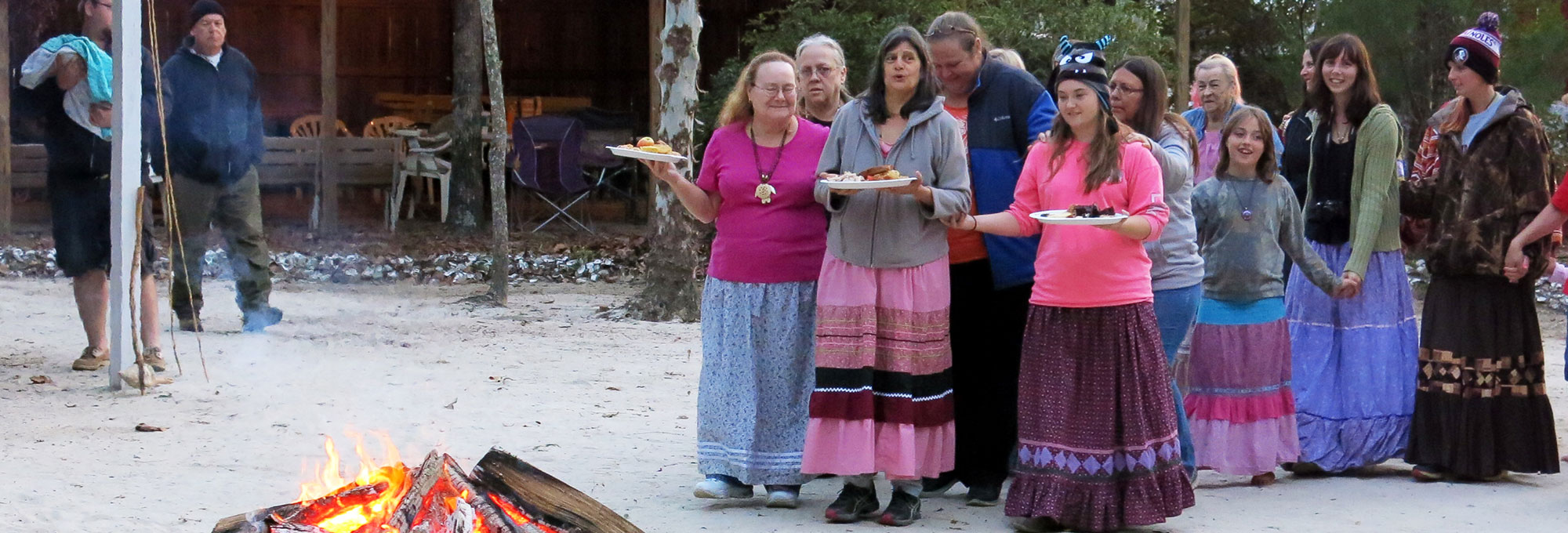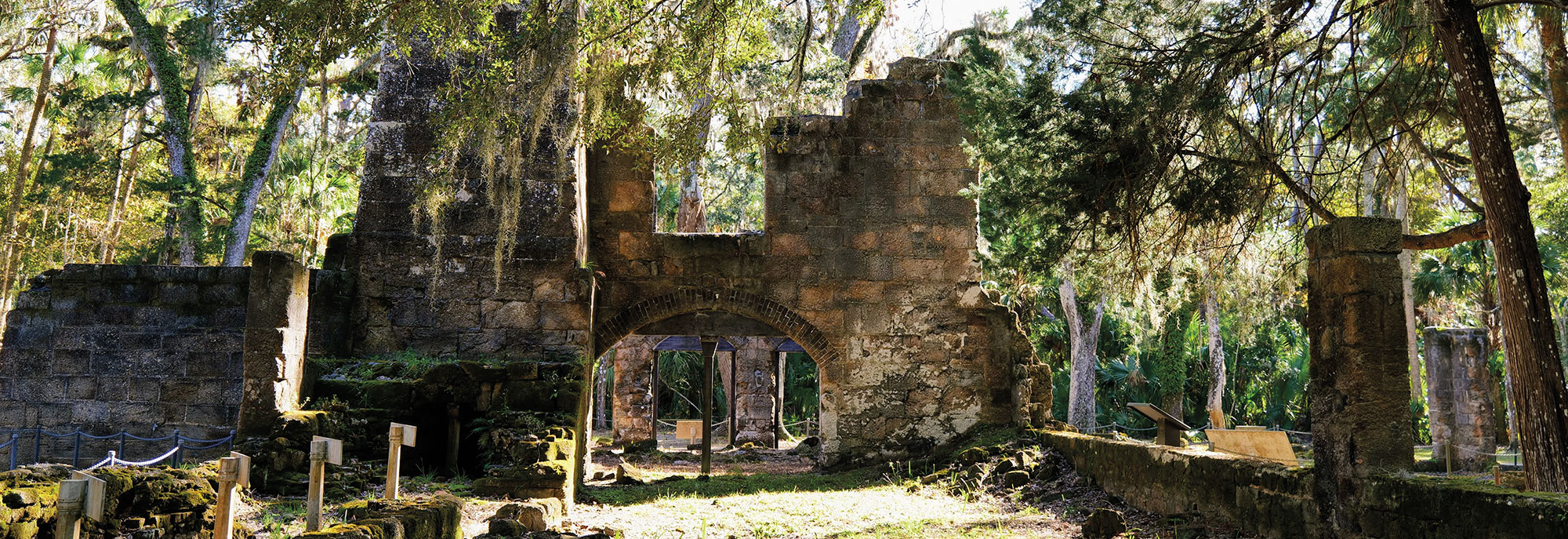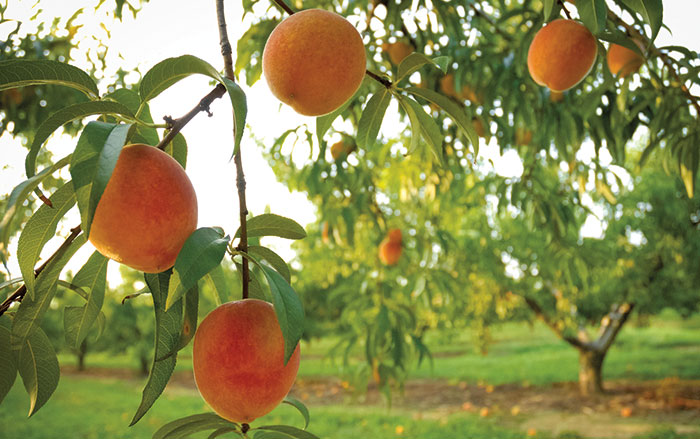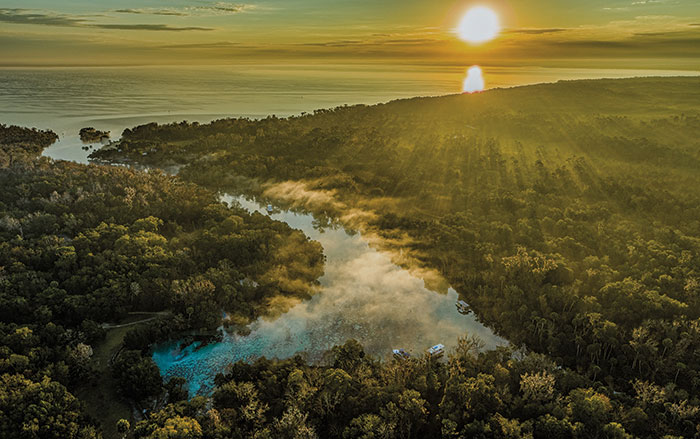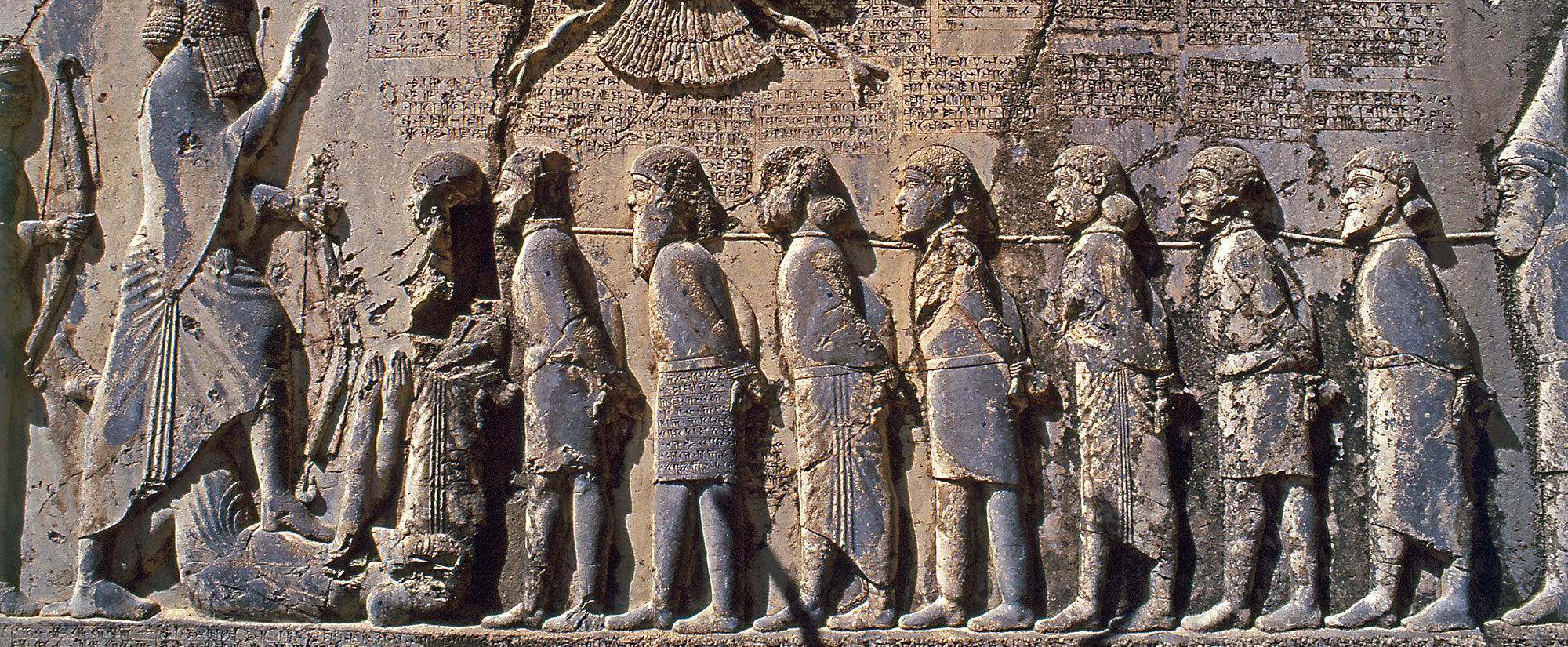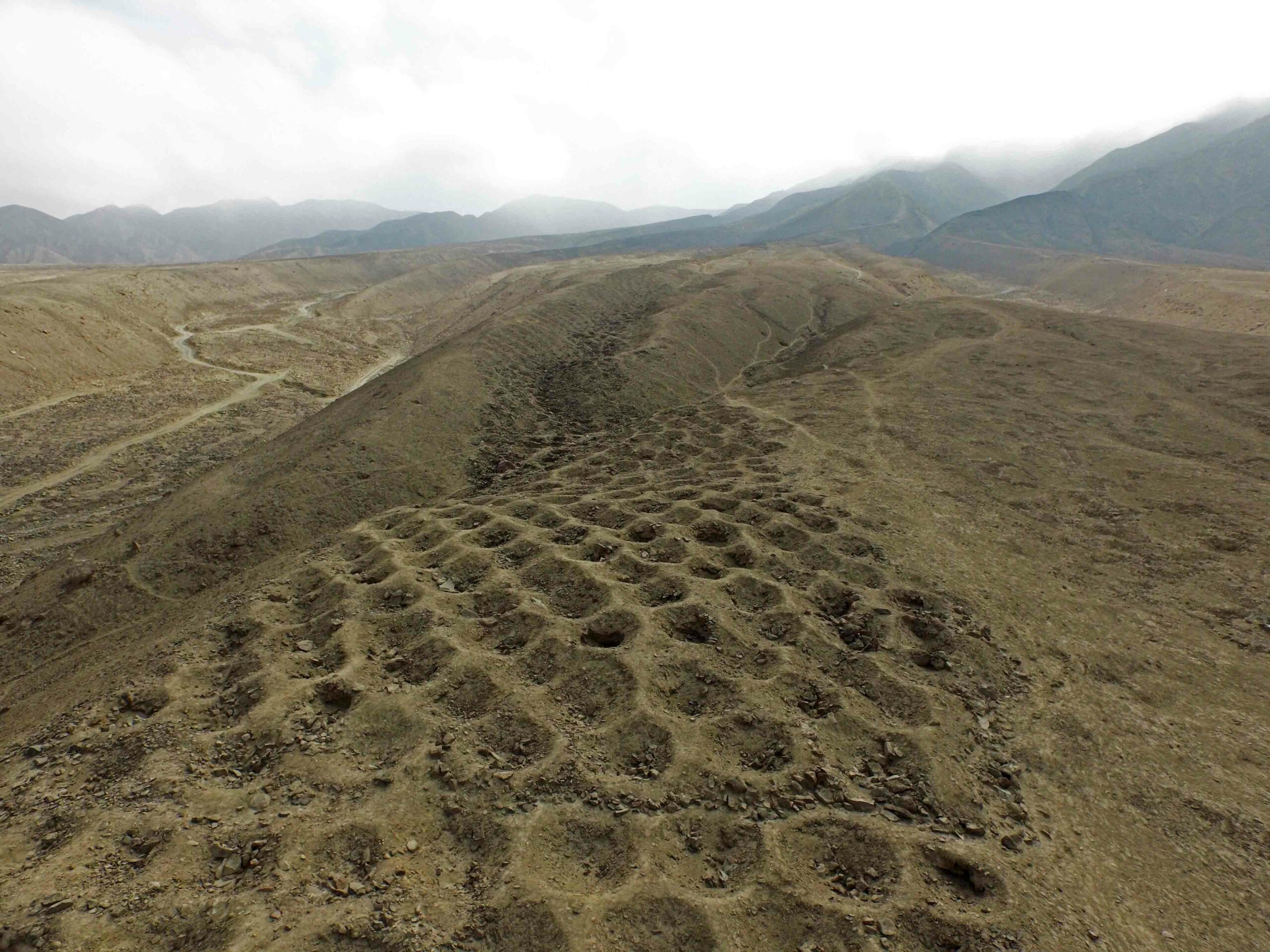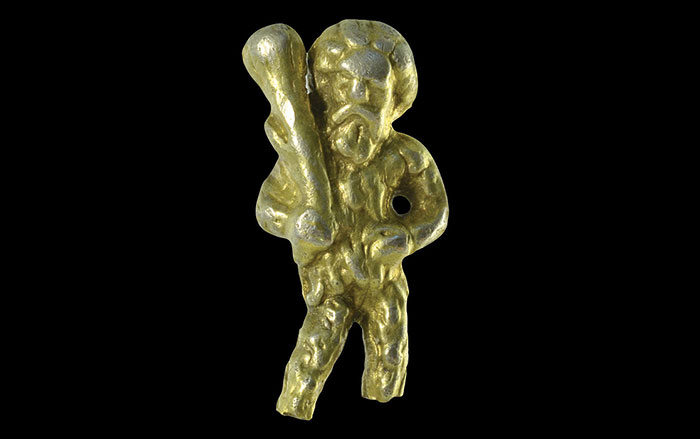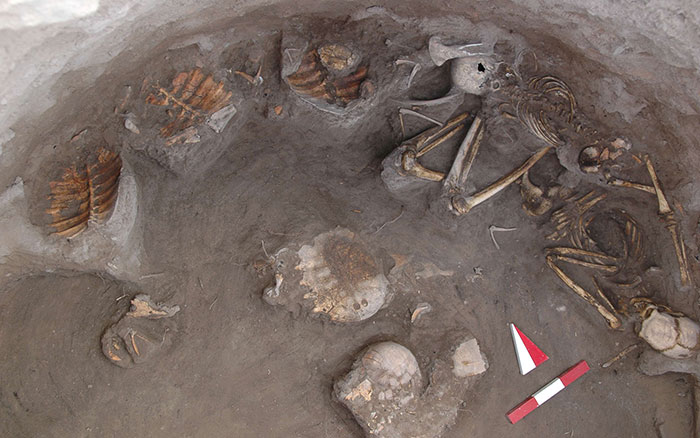On a crisp autumn morning in Florida’s Panhandle, the people of Ekvnv Hvtke, White Earth Tribal Town, gather across from the soccer field on the outskirts of Blountstown to affirm traditions that echo the time before Europeans came to America. People have parked their pickup trucks a respectful distance away from the clearing where, for the next few days, ancient traditions will rule. Surrounded by towering longleaf pines, a ring made up of sand and sun-bleached shells encircles four open-air shelters engraved with the icons of the bear, deer, otter, owl, and other clans of the Muscogee Creek people. Here, for now, the twenty-first century takes a back seat to one community’s reverence for the past. A mournful blast on a whelk shell signals the start of White Earth’s annual harvest ceremony.
Around the fire pit of the ceremonial grounds everyone has their assigned place at each of the cardinal points on the compass, much as their ancestors did in the days when earthen mounds dominated the landscape of the Southeast. The “old warriors” occupy benches under a willow-thatched arbor on the north side of the grounds. Younger men sit in a similar arbor to the south. The west arbor is reserved for tribal leaders, among them Dan Penton, a former Florida archaeologist who is the community’s traditional chief and heles-haya, the maker of medicine. The women remain outside the grounds until their time comes to enter.
The ceremony, or “busk”—an English derivation of the Creek puskita, meaning “to fast”—begins at midmorning with ritual sweeping of the grounds, the lighting of the fire, a traditional stomp dance, and a display of a bundle of relics the community holds sacred. Later, the women perform the traditional ribbon dance and offer the first food of the day—not to the men, but to the fire. Even a casual observer would have no trouble recognizing the ceremony as a gathering steeped in Native American traditions. To the U.S. Bureau of Indian Affairs (BIA), however, this is not—at least not yet—a gathering of one of the more than 500 tribes that are recognized by the federal government. For nearly 70 years, the Muscogee Nation of Florida has petitioned for official government acknowledgment, which tribal leaders say will give them access to social and medical programs, protection for tribal lands and graves, and the right to govern themselves as a recognized sovereign people.
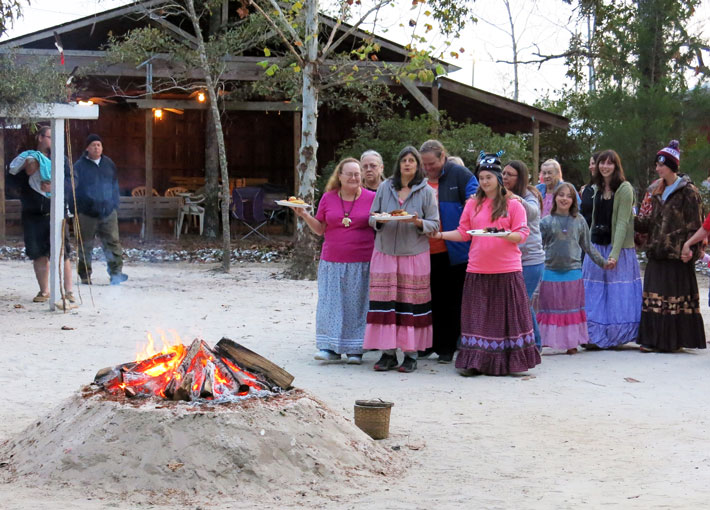
Despite the group’s appeals, the BIA’s Office of Federal Acknowledgment has insisted that without documentation of “continuous tribal existence” the Muscogee simply don’t meet the government’s definition of a tribe. Nonetheless, under new streamlined rules for tribal recognition, in late 2015 the BIA began a new review of the Muscogee petition that might resolve the matter. As the standoff goes on, unfortunately, the tribe’s elders, including some of its last speakers of the Hitchiti language, have been dying. Penton himself, whose grandfather was a maker of medicine, is pushing 70. And Penton is worried that, as the years winnow the ranks of elders, the traditions that bind his people to their past are slipping away. “Without more of our young people coming to these busks, I don’t know that this ground will survive much longer,” he says. “It’s hard to compete for their attention in this age of video games.” The threats to Muscogee identity come on a variety of fronts. But the responses to those threats arrive from many quarters, too.
Among the “old warriors” in the north arbor, you will often find Texas State University anthropologist F. Kent Reilly III, a specialist in the prehistoric art and iconography of the Mississippian chiefdoms that ruled the Southeast from A.D. 1000 to 1550. As a field consultant and adopted member of the tribe, Reilly has spent 20 years observing White Earth’s ceremonial events and getting to know the community. Reilly has been helping them uphold a past that, for many younger members, often seems distant and remote. In addition to advising the tribe on historical research—the paper trail of land ownership and cemetery records that documents their years in Florida—he shares his knowledge of prehistoric Mississippian symbols, rituals, and administration with tribal officials. In return, Reilly and the graduate students who often accompany him to the busks get a glimpse of traditions that once could only be inferred from the archaeological record or gleaned from reports by nineteenth-century ethnographers.
“When I first came here, I was just blown away by what I saw,” Reilly says. “Everything—from the layout of the square ground, to the order of the dances, to the plants they use to make their medicine, to the contents of the sacred bundle they unwrap at every ceremony—was straight out of Swanton.” John R. Swanton was the ethnographer extraordinaire of the Smithsonian Institution’s Bureau of American Ethnology. He spent a half-century studying Indian cultures in America, including Muscogee Creek communities in Oklahoma, where most of the people of the Creek Confederacy went after being forced off ancestral lands in Georgia and Alabama in the 1830s—a removal known today as the Trail of Tears. That infamous event was a watershed in the history of the Florida Muscogee.
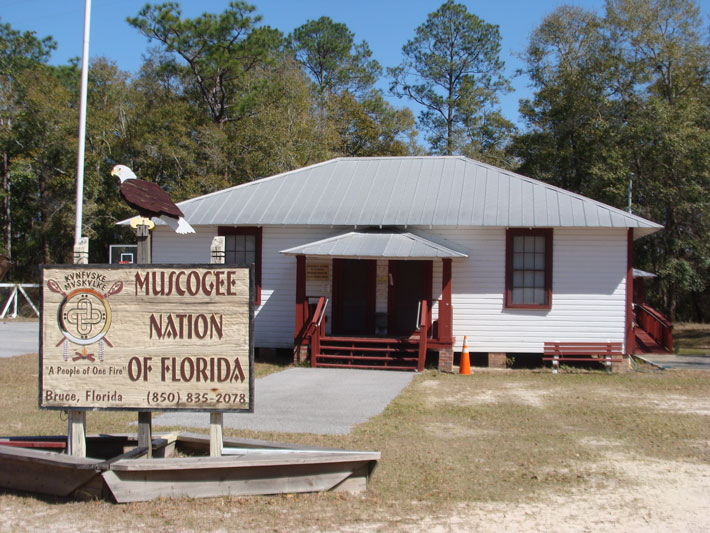
Today, the persistence of Muscogee traditions over five or six generations in a remote corner of Florida is remarkable. The Florida Muscogee’s ancestors didn’t go to Oklahoma with the rest of the Muscogee Creeks. They broke off from the larger portion of the Creek Confederacy, creating a swerve in the stream of their history. To escape removal to Oklahoma, small bands fled south, down the Choctawhatchee and Apalachicola rivers into Florida. Once settled there, however, these groups faced a new problem. In the mid-1800s, Florida banned all trade with Indians and made it illegal for anyone to identify as an Indian. Local and state laws allowed just three racial identities: black, white, or mulatto. By fiat, if not in fact, there were no Indians in northern Florida. Nearly a century would pass before federal authorities acknowledged the presence of the Muscogee there.
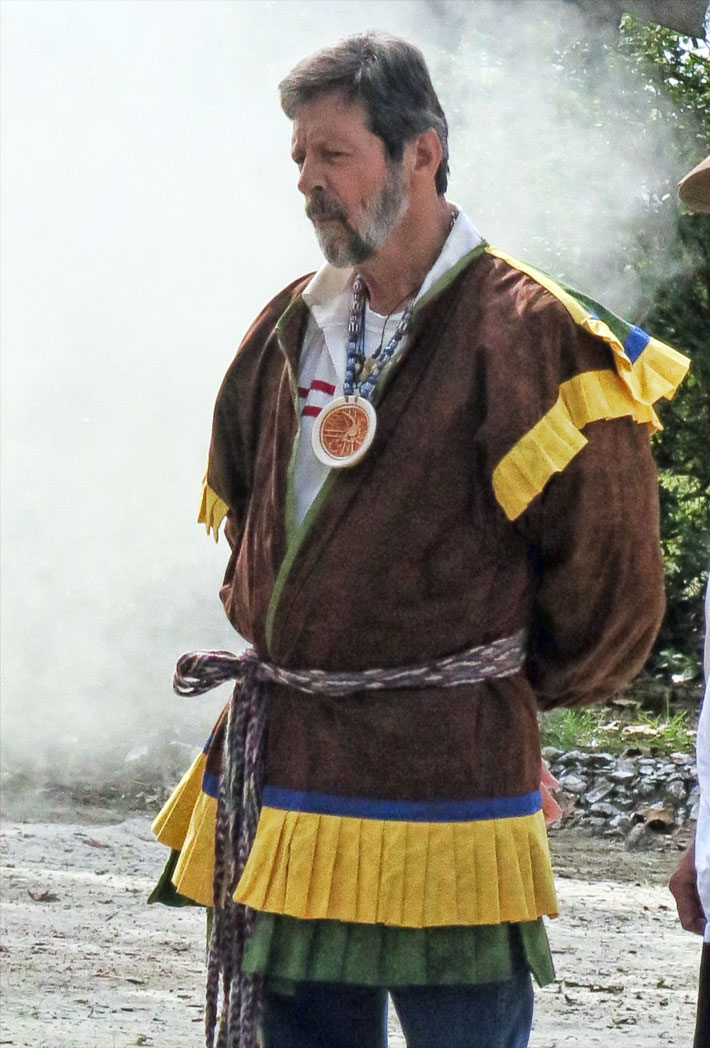
In 1957, the United States agreed to pay reparations—a few hundred dollars apiece to Indians living in the Southeast who could prove their Creek ancestry—for the government’s failure to honor terms of the 1814 Treaty of Fort Jackson with the Creeks, which was supposed to compensate them for lost territory. Several hundred of the Muscogee in Florida received such payments. Thus they were officially Indians. But they were still not, in the eyes of the federal government, a tribe. While the state of Florida recognized the tribe in 1986, the BIA continued to insist that, without proof of the community’s “continuous tribal existence by external identification,” there could be no federal recognition. And that, for the Florida Muscogee, has been the catch-22.
“The BIA wants written documents that don’t exist because Jim Crow laws criminalized interactions with our tribe,” says Ann Denson Tucker, chairwoman of the Muscogee Nation of Florida, now headquartered in Bruce, Florida. The tiny town is 40 miles west of Blountstown’s White Earth Tribal Town, the last of several ceremonial grounds—including one near Bruce that is no longer in use—that once dotted the Florida Panhandle. Blountstown itself, the county seat of Calhoun County, attests to the region’s heritage. It was named after Chief John Blount, a Creek warrior who fought with Andrew Jackson in the early 1800s.
Those deep ties to the landscape are of little help to the Muscogee today. “When the category of ‘Indian’ as a race was eliminated, it left a documentary void in the tribe’s history,” says Tucker. “Outside anthropologists never visited us because everyone ‘knew’ there were no Indians in Florida.” As recently as the early 1970s, when Tucker, who is now 62, registered to vote, she was ordered to list her race as “other.”

But Tucker’s Muscogee roots—and those of many of the roughly 600 other people on the tribal rolls—are literally etched in stone. In the nearby Antioch tribal cemetery, a simple headstone marks the grave of the community’s founder, Diamond Joe Ward, who guided Creeks from their traditional home in Alabama to the thick pine forests along Florida’s Choctawhatchee River. Diamond Joe, born in 1830, was Tucker’s great-great-grandfather. Her other ancestors lie nearby, their graves marked in traditional style with mussel shells and weathered cypress stakes bearing diamond and circle motifs. In and around Bruce, the tribe’s history is solidly anchored in the unbroken chain of land held for a century and a half by Indian families, in the 110-year-old Pine Level School attended by generations of Indian children, and in the nearby Methodist mission church that has ministered to the Indians since the early 1900s. “Despite all the government has done to try to erase us from history, my tribe has lived on this land as a cultural, social, and political unit for more than 150 years,” says Tucker. “Whether the government chooses to recognize us or not, we know who we are.”
While Tucker presses the legal case for federal recognition, Penton is struggling to preserve another, more ephemeral, aspect of the tribe’s legacy. The busks over which he presides nurture traditions that are firmly rooted in the agrarian Creek communities of the Southeast and in the Mississippian culture from which they descend. The first ceremony of the year, the onion busk, coincides with the early spring emergence of wild onions. The berry busk comes as the mulberries ripen. As the year unfolds, green corn, little green corn, harvest, and the winter soup ceremonies follow the procession of nature’s seasons.
As a former senior archaeologist for a Tallahassee cultural resource management firm, Penton holds convictions that are firmly planted in two worlds. He has a degree in anthropology, and much of what he knows about the Muscogee past comes from the world of science. But while he keeps the works of Swanton and the pioneers of Southeastern archaeology such as Clarence Bloomfield Moore on his bookshelf, he also keeps his grandfather’s carved wooden staff—embellished with a coiled snake—as the symbol of a different kind of knowledge and authority. He says most of what he knows about the use of traditional medicines and the busk ceremonies comes from his upbringing and that of other members of the tribal town. His archaeological career was deeply influenced by his familiarity with his tribe’s traditions, especially those associated with the busks held at the tribe’s ceremonial grounds.
According to Penton and other scholars, there is good evidence that the square ground itself, with the sacred fire at the center and the four arbors aligned to the cardinal points, existed during Mississippian times and even earlier. The remains of these grounds are often found at larger sites that would have been associated with the ceremonial life of these ancient peoples. “Every one of these traditional tribal towns would have had its own interpretation of the busk,” says Penton, “but the ceremonies did follow a template associated with the square ground.”

While digging at Florida sites such as the Mississippian mound complex of Lake Jackson or the earlier Swift Creek culture (A.D.100–800) site of Bird Hammock, he used his knowledge of the Muscogee ritual template to help understand what he unearthed. When studying likely ceremonial remains, he focused on the significance of cardinal directions at the site, as well as the delineation of ritual space and the role different parts of the site may have played in the seasonal ceremonial calendar. When he discovered artifacts made of such materials as shell, copper, mica, greenstone, and quartz, his Muscogee background gave him insight into their possible significance as objects of ritual “medicine.” In the 1990s, he excavated what turned out to be an eighteenth-century ceremonial square ground near Panama City, Florida. “I’m not sure I would have recognized it,” says Penton, “if I had not experienced a busk.”
As the harvest ceremony continues at the White Earth ground, Penton nods toward the center of the square ground. There, the ceremonial fire burns brightly, sending a faint column of smoke skyward. “That fire has been in this area for over 200 years,” says Penton. Early ethnographers in the Southeast noted that the embers of Creek ceremonial fires were distributed to individual households at the conclusion of each ceremony so that “the one fire” would be there to relight the next ceremonial blaze. While continuity may well be the hallmark of such traditions, adapting the old ways to changing times is often the key to their survival. The eternal fire continues, but these days White Earth’s flame lives in the pilot light of a water heater and returns to the busks in a kerosene lantern when it is needed.
The fire itself has multiple meanings. “What you don’t see—and won’t see if you’re an outsider—is what’s down there beneath the fire mound,” explains Reilly as he warms himself by the flames. A number of important objects have been buried by the community there. One of them is a clay turtle, a symbol of the turtle upon which the Earth was built. “This spot right here,” he says, “with the turtle below and the smoke rising into the sky, is the axis mundi, the place in indigenous belief systems where the upper world, the middle world, and the world below meet.” Reilly says the convergence of the three parts of the cosmos is found in iconography from several major sites—including the well-known “pole of the world” inscribed shell medallion from Spiro Mounds in eastern Oklahoma.
Another of the busk ceremonies with deep roots in prehistoric North America is one in which Reilly himself often plays a key role. Soon after the busk begins, you will find him hunched over a hot iron skillet, roasting freshly gathered leaves of yaupon holly, Ilex vomitora, on a propane stove. Once they are blackened, the pungent leaves are boiled in a kettle of water to produce a soupy, caffeine-rich brew that becomes the feed stock for the “black drink,” which indigenous people have used in rituals for thousands of years. Residues of the drink have been found in engraved ceramic cups that date to A.D. 1100 at the Mississippian city of Cahokia. Similar shell cups found at Hopewell sites in the Midwest suggest that the drink was used there more than 2,000 years ago. Although the black drink—now called asi-hvtke, the “white drink,” by the Muscogee—is thought to have been used as a purifying emetic to cause ritual vomiting, Reilly says it actually tastes like a semi-palatable cross between coffee and cough medicine.
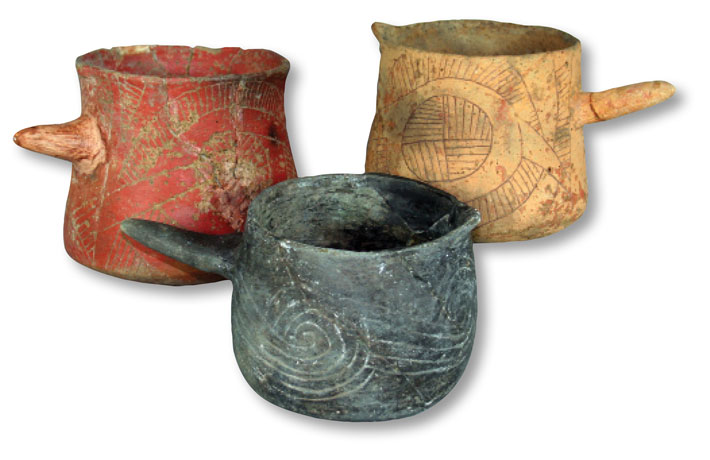
Yaupon holly is not the only plant with a role in the ceremonies. Before the busk begins, the men of White Earth head into the woods to collect a potpourri of native plants—button snake root, rabbit tobacco, sweet gum, bald cypress, bay laurel, and other species that will be used for rituals or medicine. This Muscogee pharmacopoeia covers a broad range of physical and emotional ailments. Swanton’s Creek Religion and Medicine, in fact, documents at least 105 plant-based medicines used by the Muscogee people. As the maker of medicine, Penton still prepares many of them and distributes them to members of the community as needed.
As in earlier Creek and Mississippian cultures, Penton is also the custodian of the community’s sacred bundle—a collection of artifacts and revered objects that have been handed down from generation to generation. Similar bundles, wrapped in cloth or hide, have been found in the graves of high-status Mississippian individuals. Excavations at Cahokia, Moundville, Etowah, and other Mississippian sites have unearthed examples with widely varying contents—from bits of bone, antlers, and wooden carvings to the dish-sized decorated stone palettes that were used for the ritual mixing of paint. White Earth’s objects, which include lithic points, stone axheads, rattles, shell medallions, and a peace medal awarded by President James Madison, are carefully unwrapped for public display at each busk.
In a less visible but more fundamental way, the White Earth community also echoes another enduring aspect of indigenous culture. “All of these societies were matrilineal,” says University of South Carolina archaeologist Adam King, who often attends the ceremonies as a guest. “The men’s role at these busks is ceremonial. It is the women—led by the matriarch—who own the grounds. And they are the ones who choose the leaders, including the maker of medicine. This is a set of principles and beliefs that goes way back. It’s not something they got by reading it in a book.”
For anthropologists like Reilly and his students, the opportunity to observe and participate in the Muscogee busks provides a rare glimpse of a culture that, even while threatened by the modern world, maintains its identifiable roots in prehistoric America. “Artifacts can’t tell us everything, especially about religion and belief systems as an organizing factor in society,” says Reilly. “But we can get a much clearer picture if we use a combination of the archaeological record, historical and ethnographic sources, and the testimony of living people like these. Their traditions provide us with a unique door to their past. And right now Dan Penton is the gatekeeper.”
As both the tribe’s maker of medicine and a former archaeologist, Penton is well aware of his custodial role at the intersection of past and future. And he is worried. The community’s traditions are in danger of slipping away—and it is his responsibility to preserve them.

Every busk now includes an educational session that, in another setting, might pass for Sunday school. Penton and other tribal leaders intently quiz younger members on the meaning, origins, and proper etiquette of the Creek traditions. The exchanges are good-humored but serious. Why must all movement around the central fire be in a counterclockwise direction? Why do the women wait outside the ground until they are invited in? Ceremonial etiquette is also part of the instruction.
“In one form or another, the harvest busk has been around for a thousand years or more,” Penton says. “Its traditional purpose is to realign the cosmos—to temporarily stop time in order to mark the transition from the growing time of the year to the time for hunting.”
Increasingly, however, it has also become a time to learn. “A lot of what we discuss would have been common knowledge a generation or two ago,” says Penton. “But almost no one is raised in the tradition any more. So the busk is an open discussion of what’s behind the symbolism. We are more open about things than we used to be. If we are going to survive, we have to share it. We are the custodians of our culture, whether the federal government recognizes us or not.”


